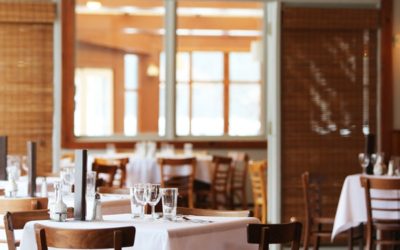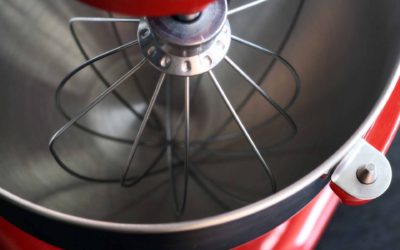5 Tips for an Ergonomically Sound Restaurant
June 1, 2017The physical environment of your restaurant should not only be appealing to customers but also be comfortable and safe for your employees.
Due to the repetitive motions that characterize the job description of restaurant employees, there is a potential for musculoskeletal injuries. Ergonomics is the practice of providing a work environment that minimizes the risk of such injuries. To make an ergonomically sound restaurant for your employees, consider implementing the following.
- Ergonomically Sound Restaurant Tip: Use Push Carts for Serving
Tray carrying can cause pain in the arms and wrists. As much as possible, reduce tray carrying and use carts instead. Arrange the interior of your restaurant in such a way to allow easy movement of carts. If you choose not to use carts, teach your servers to use both hands to carry plates and trays. Whenever large parties are to be served, more hands should be involved. These measures will help prevent straining of the wrists.
- Ergonomically Sound Restaurant Tip: Provide Anti-Fatigue Mats
To prevent discomfort and fatigue of employees’ feet, legs and lower back, providing anti-fatigue mats in areas where employees stand for long periods of time. You should also consider padded floors, especially in the kitchen, where most tasks are done while standing. Softer surfaces will take some of the pressure off employees’ feet, reducing discomfort and injuries.
- Ergonomically Sound Restaurant Tip: Make Cushioned Insoles Mandatory
Any employee on duty should be required to wear shoes with cushioned insoles. This will reduce the occurrence of the foot and leg pain that is common with repetitive standing movements. If possible, shoes should be provided to increase compliance with your restaurant’s footwear policy.
- Ergonomically Sound Restaurant Tip: Use Knives the Right Way
Dull-edged knives make it necessary for your cooks to use extra force when cutting foods. This adds to the physical strain of knife usage. Kitchen knives should be sharpened often to prevent unnecessary use of force. Also instruct your kitchen staff to use the appropriate knives for the type of food they are cutting, and to never cut foods without using a cutting board.
- Ergonomically Sound Restaurant Tip: Encourage healthy behaviors
Encourage your employees to take care of their musculoskeletal system by drinking enough water. They should also be provided with mandatory stretch breaks. A restaurant can be a fast-paced and exhausting environment, but encouraging regular exercise outside of work can keep employees more physically fit and help their bodies withstand the pressures of the job.
As a restaurant owner, it is your responsibility to ensure the safety of your employees. In addition to providing the proper equipment and restaurant design to reduce ergonomic sound restaurant issues and safety hazards, proper training on work organization, safe performance of tasks and handling of emergency situations should be provided. Proper ergonomics will have your employees performing at their best and reduce absences and injury lawsuits. It is an investment well worth making.
5 Keys to Creating the Perfect Restaurant Seating Areas
Restaurants are about so much more than just food. From the setting and layout of your restaurant to your choice of colors, it takes a lot more than an appealing menu to keep diners coming back for more. When setting up your restaurant, booths and chairs are important...
5 Essential Buying Tips for Your Next Food Prep Work Table
The right foodservice equipment is pivotal to the efficiency of your kitchen. One of the most important types of foodservice equipment for any kitchen is the work table. With limited room on countertops available for your food prep needs, the cooking process can drag...
Tips for Keeping Your Commercial Sink Sparkling Clean
Your commercial kitchen, just like your personal kitchen, must be kept clean at all times. With all of the cooking and food processing you do, it is inevitable that your sink gets messy. Cleaning up your commercial kitchen is incomplete without proper cleaning of your...
Food-Cutting Secrets to Beautiful Dishes
In the restaurant industry, presentation is often said to be just as important as the food itself. Using the right knowledge, skills and restaurant supplies, you can incorporate creativity into your presentation, making guests feel that they are getting something...
Top Space-Saving Tips for Commercial Kitchens
Top Space-Saving Tips for Commercial Kitchens Space is always an important consideration when setting up a kitchen, and this is even truer for commercial kitchens. With a strong focus on functionality and the kitchen supplies that meet the needs of your commercial...
5 Ways to Get the Most Out of Your Mixer
No one wants to eat off of dirty or tarnished silverware. A stand mixer is a highly useful piece of kitchen equipment to invest in. Although this type of kitchen equipment does not usually come cheap, it can last a lifetime when properly cared for. Despite all your...
Restaurant Prep Tool Selection Simplified
What’s a restaurant kitchen without high-quality prep tools that can withstand the pressure of frequent use? Whether you already have a restaurant you’re running, or you’re just planning to launch one, one vital factor that could make or mar your business is how you...
Beginner’s Guide to Choosing a Commercial Ice Cream Freezer
Ice cream is a delicious and appealing desert treat for everyone, young or old. Having made the decision to sell ice cream to your customers, whether you have a restaurant, convenience store, or specialty ice cream parlor, it is time to begin stocking up on the right...
How to Choose the Right Kitchen Scales for Your Restaurant
A food scale is an essential item in every restaurant’s store of kitchen supplies. Designed to take the guesswork out of food measurement and maintain consistent food serving sizes, food scales are indispensable kitchen supplies in the commercial kitchen. With such a...
Beer Chilling Systems: Which Type Is Right for My Restaurant?
A refrigeration unit is integral to the functioning of any restaurant. Beers are best served cold - there’s no questioning that! But which beer chilling system is the best? From reach-in coolers to glycol chillers, a beer chilling system is an important piece of...
What Equipment Will I Need to run a Food Truck?
There’s a lot of planning that goes into starting your own food truck business. Before you hit the road with your delicious food offerings, you’ll need to fill up your truck with all the right foodservice equipment. Considering the lengthy list of possible items to be...
8 Types of Food Thermometers: What You Need To Know
Food thermometers are essential restaurant supplies for your commercial kitchen. They ensure that foods prepared in your commercial kitchen are cooked to the right temperature and held at that temperature for as long as necessary to kill any harmful bacteria. This...
How to Identify the Best Food Processor for Your Needs
Highly versatile and extremely efficient, food processors are designed to take away the hard work from repetitive kitchen activities. This type of cooking equipment can quickly become an invaluable tool in your kitchen. From chopping, to shredding, grinding, mincing,...
6 Keys to Choosing the Best Chafing Dishes for Your Restaurant
The chafing dish, also known as the chafer, is an essential piece of restaurant equipment for any establishment that wants to keep food hot. This type of restaurant equipment gets its name from the French word, chauffer, which means to heat, and it’s easy to see why....
Turning up the Dial on Commercial Fryers: How to Choose One for Your Restaurant
Fried food is a well-loved favorite. This is a fact. It also makes a fryer an important piece of equipment to have in your commercial kitchen. Just consider how many appetizers and sides require frying: onion rings, French fries, and fried green tomatoes are just a...















